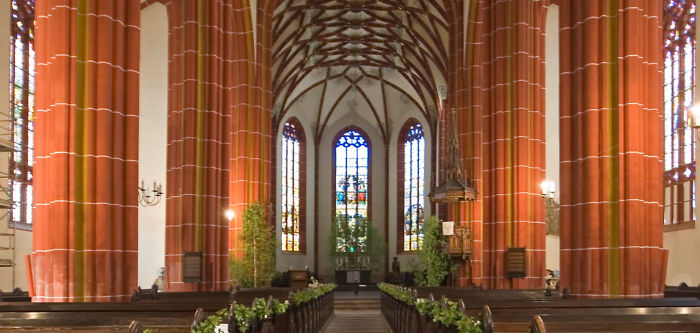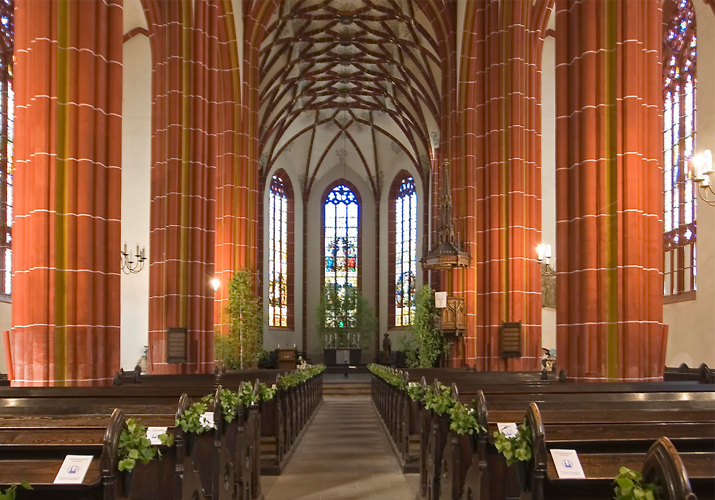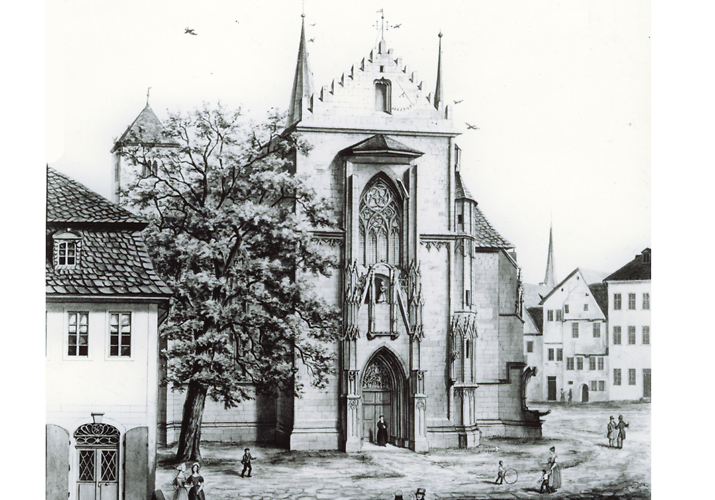St John?s Church (Kirchplatz 3)
The town’s parish church was dedicated to John the Baptist, and his statue stands inside it. There was once a Romanesque basilica on this site, which was destroyed by fire. In its place one of the largest hall churches in Thuringia was built, which took over 100 years to complete. It was consecrated in 1514. Peter Parler of Bohemia and his builders were able to create a magnificent architectural masterpiece. Both of the church towers are 64 metres high. They contain six bells, the oldest of which was cast in 1400 and weighs four tonnes.
Over the entrance portal one can see a many-figured portrayal of the Last Judgement. Above the arched doorway there is a rare relief depicting the “Holy Grieving”. It originally adorned the façade of an earlier chapel on the bridge over the River Saale, and shows Christ the Redeemer with a minstrel at his feet. It was inspired by a crucifix in the Cathedral at Lucca in Italy.
On the strength of this unusual group of figures, there arose in the Middle Ages the legend of a beautiful princess who, in order to avoid the affections of her admirers, pleaded with God to make her ugly. Thereupon a long beard grew on her chin. Her father, in his fury, nailed her to a cross. At the hour of her death she threw a golden slipper to a minstrel, who was trying to console her.
When you enter the church, remain for a while in the entrance area so that you can take in the diversity of colour and the massive pillars…
Now look upwards. On the ceiling vault of the entrance hall you will see a four-leaf clover when entering the church this is a symbol of luck. In the middle is Christ, portrayed as a lamb, which represents sacrifice, the forgiveness of sins, and redemption.
The red on the pillars represents Christ’s blood and refers to God’s love and sacrifice. If one were to cut through these pillars you would again see the form of a four-leaf clover. Because of this clustered motif, these are known as clustered pillars.
In the choir you will discover what is surely the most beautiful treasure of this church: the painted ceiling vaults. The “Heavenly Meadow” is the most comprehensive representation of plant life in late gothic ceiling painting in the German-speaking region. It originates from the 16th Century and delivers a threefold message: that of the open heavens, God loves all his creations alike, cares for the variety and beauty of his handiwork and protects all that is living.
Over 200 plants are portrayed, all with their healing power and significance. 80 of them can be identified botanically. Among these are the lily symbolising Mary, the aquilegia as a sign of the Trinity, the dandelion, the narcissus, and the carnation as a symbol of the Passion, and triumph over death.
The choir windows recount the life of Jesus and explain the meaning of the four principal Days of Christ in the Christian year: Christmas, St John the Baptist’s Day, Good Friday and Easter Day. These windows date from the remodelling of the church in 1900.
One unique artwork in the choir portrays, in wood, a life size figure of John the Baptist, the patron saint of the church. It is believed to be the principal work of the Saalfeld carver Hans Gottwald von Lohr, a pupil of Tillmann Riemenschneider.
There has not been a Roman Catholic mass in this church since 1524. During the Reformation Martin Luther preached here several times, and in remembrance of Luther and his work, a sculpture was presented to the church in 1905. This can be seen to the left of the entrance.
The next destination on your tour is the Town Museum in the former Franciscan monastery. The route to it leads from St John’s Church along the Blankenburger Strasse. Proceed along it to the left as far as the Brudergasse. This begins at the level of the market place. When you turn right into the Brudergasse, you will already see the huge building of the one-time monastery at the end of the street.



